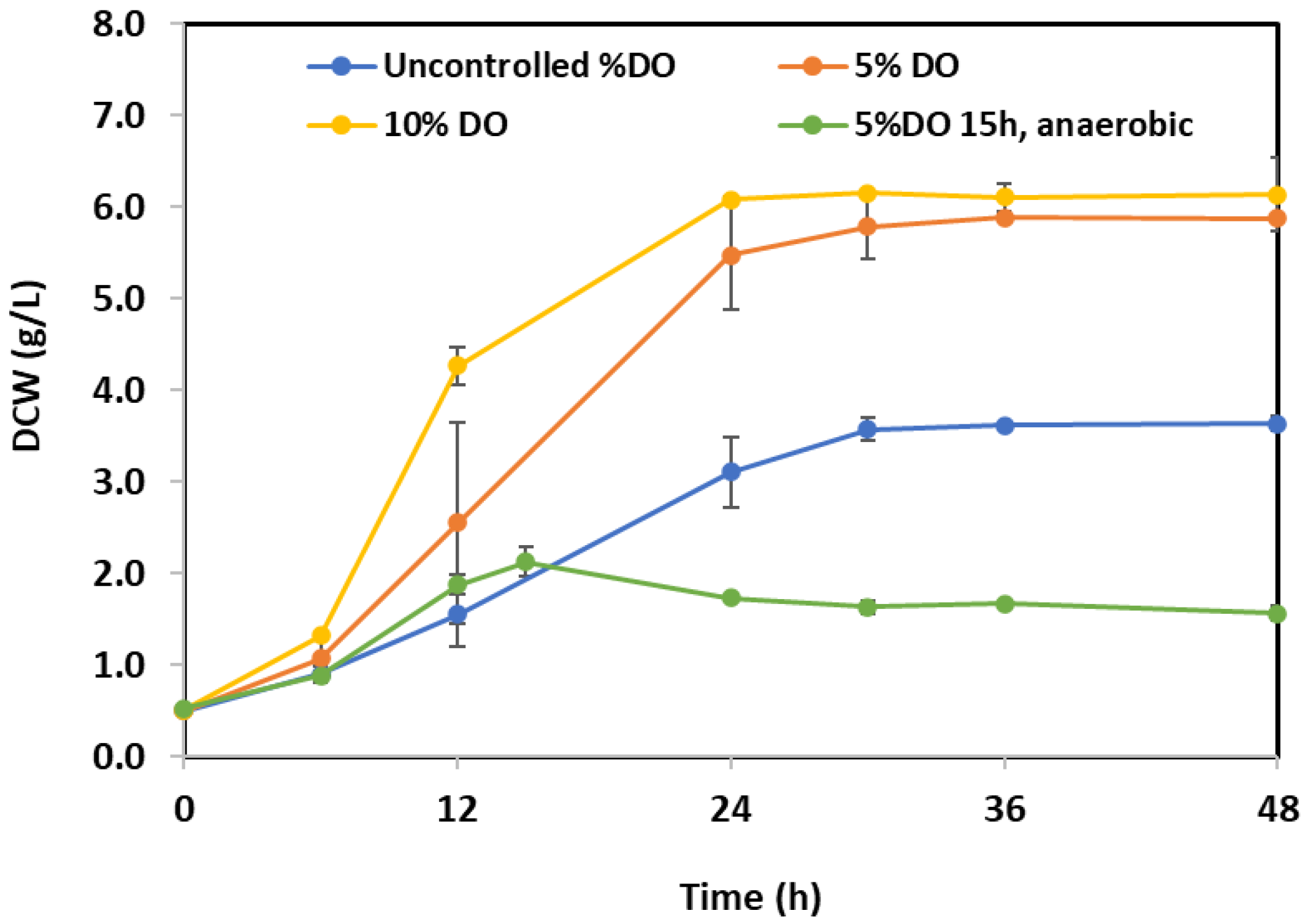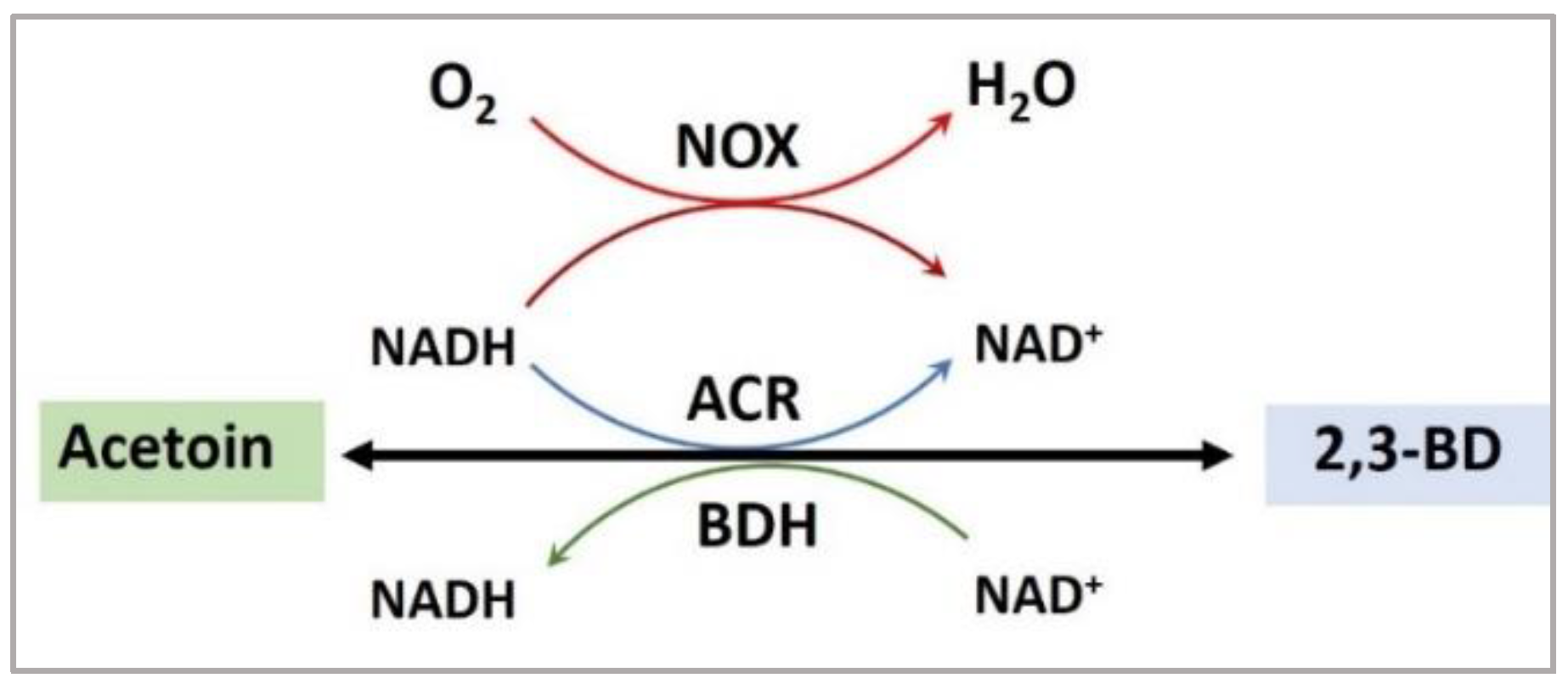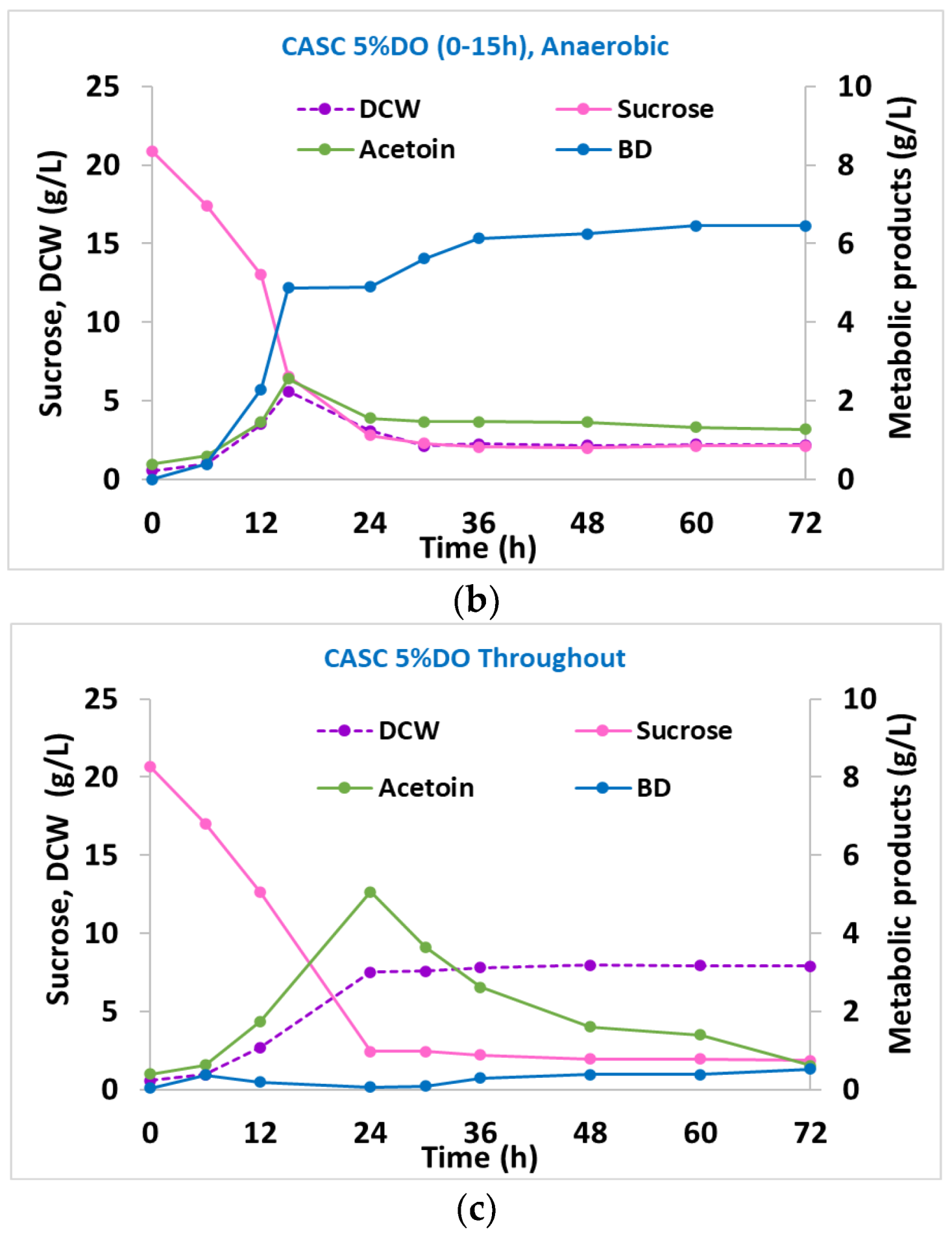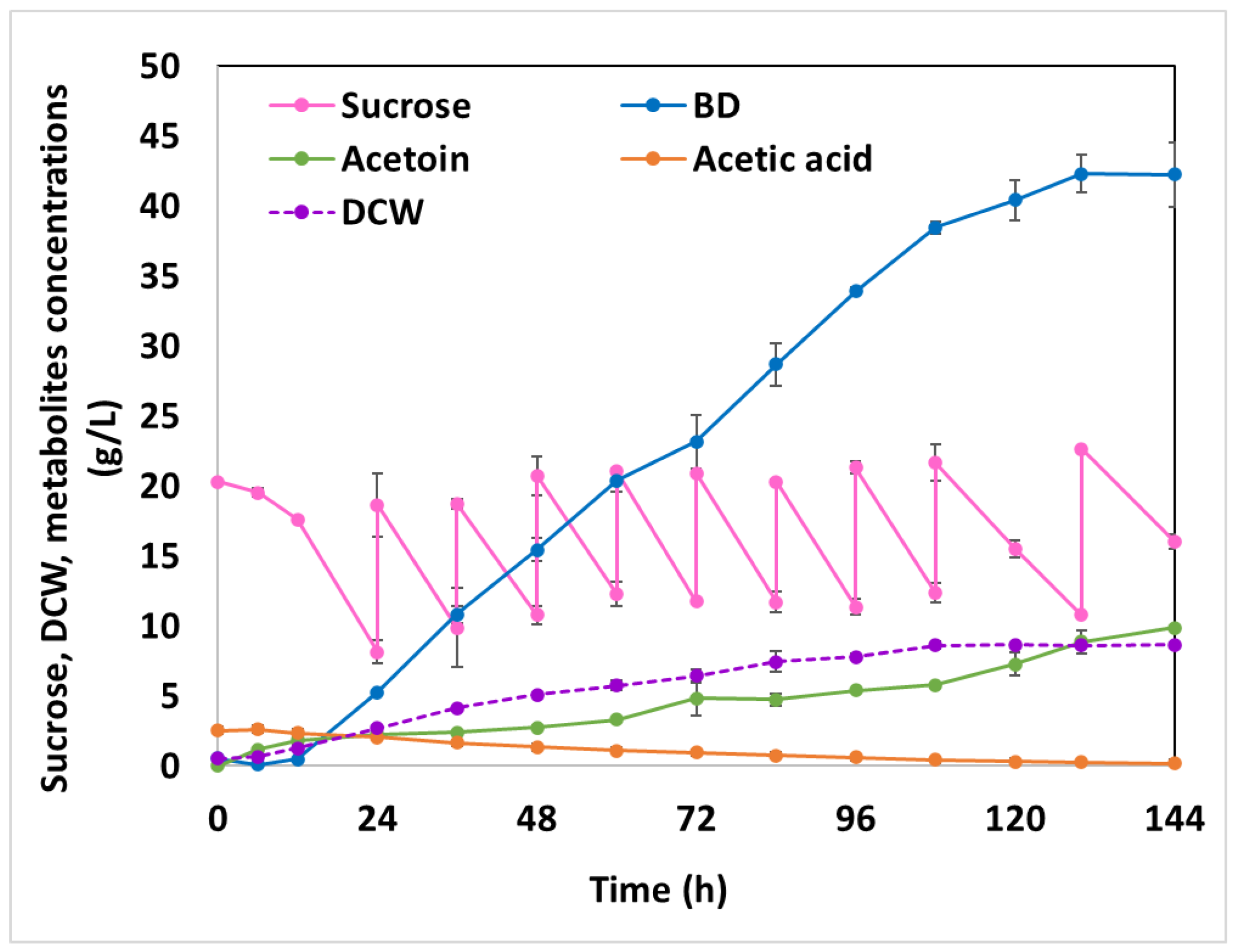Biotechnological Production of Optically Pure 2,3-Butanediol by Bacillus subtilis Based on Dissolved Oxygen Control Strategy
Abstract
:1. Introduction
2. Materials and Methods
2.1. Microorganisms
2.2. Pre-Culture and Production Culture Media
2.3. Effect of Different Nitrogen Sources on 2,3-BD Production
2.4. Effect of Carbon to Nitrogen (C/N) Molar Ratio on 2,3-BD Production
2.5. Effect of Dissolved Oxygen Control Strategies in Growth and 2,3-BD in 2-L Bioreactor
2.6. Fed Batch Cultivation for 2,3-BD Production in 2-L Bioreactor
2.7. Determination of Acetoin Reductase Butanediol Dehydrogenase (ACR/BDH) and NADH Oxidase (NOX) Activities
2.7.1. Cell Preparation
2.7.2. Acetoin Reductase and Butanediol Dehydrogenase (ACR/BDH) Activities
2.7.3. NADH Oxidase (NOX) Activity
2.8. Analytical Methods
2.9. Identification of 2,3-BD and Acetoin Stereoisomeric Forms by GC-FID
3. Results
3.1. Screening of Bacterial Strains for 2,3-BD Production in Sucrose-Based Media
3.2. Effect of Alternative Low-Cost Nitrogen Sources on Cell Growth and 2,3-BD Production
3.3. Effect of Different Carbon-to-Nitrogen (C/N) Molar Ratios on Cell Growth and 2,3-BD Production
3.4. Effect of Dissolved Oxygen Control Strategy on Cell Growth and 2,3-BD Production in 2-L Batch Bioreactor
3.5. Determination of 2,3-BD and Acetoin Stereoisomeric Forms
3.6. Investigation of Metabolic Pathways in B. subtilis FSBC 322 by Enzyme Activity Assay
3.7. Enhancing 2,3-BD Production by Fed Batch Fermentation
4. Conclusions
Author Contributions
Funding
Institutional Review Board Statement
Informed Consent Statement
Data Availability Statement
Acknowledgments
Conflicts of Interest
References
- Celińska, E.; Grajek, W. Biotechnological production of 2,3-butanediol—Current state and prospects. Biotechnol. Adv. 2009, 27, 715–725. [Google Scholar] [CrossRef] [PubMed]
- Ji, X.-J.; Huang, H.; Ouyang, P.-K. Microbial 2,3-butanediol production: A state-of-the-art review. Biotechnol. Adv. 2011, 29, 351–364. [Google Scholar] [CrossRef] [PubMed]
- Song, C.W.; Park, J.M.; Chung, S.C.; Lee, S.Y.; Song, H. Microbial production of 2,3-butanediol for industrial applications. J. Ind. Microbiol. Biotechnol. 2019, 46, 1583–1601. [Google Scholar] [CrossRef] [PubMed]
- Ge, Y.; Li, K.; Li, L.; Gao, C.; Zhang, L.; Ma, C.; Xu, P. Contracted but effective: Production of enantiopure 2,3-butanediol by thermophilic and GRAS Bacillus licheniformis. Green Chem. 2016, 18, 4693–4703. [Google Scholar] [CrossRef]
- Bao, T.; Zhang, X.; Rao, Z.; Zhao, X.; Zhang, R.; Yang, T.; Xu, Z.; Yang, S. Efficient Whole-Cell Biocatalyst for Acetoin Production with NAD+ Regeneration System through Homologous Co-Expression of 2,3-Butanediol Dehydrogenase and NADH Oxidase in Engineered Bacillus subtilis. PLoS ONE 2014, 9, e102951. [Google Scholar] [CrossRef] [Green Version]
- Białkowska, A.M.; Gromek, E.; Krysiak, J.; Sikora, B.; Kalinowska, H.; Jędrzejczak-Krzepkowska, M.; Kubik, C.; Lang, S.; Schütt, F.; Turkiewicz, M. Application of enzymatic apple pomace hydrolysate to production of 2,3-butanediol by alkaliphilic Bacillus licheniformis NCIMB 8059. J. Ind. Microbiol. Biotechnol. 2015, 42, 1609–1621. [Google Scholar] [CrossRef]
- Biswas, R.; Yamaoka, M.; Nakayama, H.; Kondo, T.; Yoshida, K.-I.; Bisaria, V.S.; Kondo, A. Enhanced production of 2,3-butanediol by engineered Bacillus subtilis. Appl. Microbiol. Biotechnol. 2012, 94, 651–658. [Google Scholar] [CrossRef]
- Cho, S.; Kim, K.D.; Ahn, J.-H.; Lee, J.; Kim, S.-W.; Um, Y. Selective Production of 2,3-Butanediol and Acetoin by a Newly Isolated Bacterium Klebsiella oxytoca M1. Appl. Biochem. Biotechnol. 2013, 170, 1922–1933. [Google Scholar] [CrossRef]
- Deshmukh, A.N.; Mistry, S.R.; Yewale, T.B.; Mahajan, D.M.; Jain, R. Production of 2,3-Butanediol from Sugarcane Molasses Using Bacillus subtilis. Int. J. Adv. Biotechnol. Res. 2015, 6, 66–79. [Google Scholar]
- Häßler, T.; Schieder, D.; Pfaller, R.; Faulstich, M.; Sieber, V. Enhanced fed-batch fermentation of 2,3-butanediol by Paenibacillus polymyxa DSM 365. Bioresour. Technol. 2012, 124, 237–244. [Google Scholar] [CrossRef]
- Jung, M.-Y.; Jung, H.-M.; Lee, J.; Oh, M.-K. Alleviation of carbon catabolite repression in Enterobacter aerogenes for efficient utilization of sugarcane molasses for 2,3-butanediol production. Biotechnol. Biofuels 2015, 8, 106. [Google Scholar] [CrossRef]
- Li, D.; Dai, J.-Y.; Xiu, Z.-L. A novel strategy for integrated utilization of Jerusalem artichoke stalk and tuber for production of 2,3-butanediol by Klebsiella pneumoniae. Bioresour. Technol. 2010, 101, 8342–8347. [Google Scholar] [CrossRef]
- Okonkwo, C.C.; Ujor, V.C.; Mishra, P.K.; Ezeji, T.C. Process Development for Enhanced 2,3-Butanediol Production by Paenibacillus polymyxa DSM 365. Fermentation 2017, 3, 18. [Google Scholar] [CrossRef] [Green Version]
- Shi, L.; Gao, S.; Yu, Y.; Yang, H. Microbial production of 2,3-butanediol by a newly-isolated strain of Serratia marcescens. Biotechnol. Lett. 2014, 36, 969–973. [Google Scholar] [CrossRef]
- Wong, C.-L.; Yen, H.-W.; Lin, C.-L.; Chang, J.-S. Effects of pH and fermentation strategies on 2,3-butanediol production with an isolated Klebsiella sp. Zmd30 strain. Bioresour. Technol. 2014, 152, 169–176. [Google Scholar] [CrossRef]
- Yuan, J.; He, Y.-Z.; Guo, Z.-W.; Gao, H.-F.; Chen, F.-B.; Li, L.-Z.; Li, Y.-Y.; Zhang, L.-Y. Utilization of Sweet Sorghum Juice for Efficient 2,3-Butanediol Production by Serratia marcescens H30. BioResources 2017, 12, 4926–4942. [Google Scholar] [CrossRef]
- Nicholson, W.L. The Bacillus subtilis ydjL (bdhA) Gene Encodes Acetoin Reductase/2,3-Butanediol Dehydrogenase. Appl. Environ. Microbiol. 2008, 74, 6832–6838. [Google Scholar] [CrossRef] [Green Version]
- O’Hair, J.; Jin, Q.; Yu, D.; Poe, N.; Li, H.; Thapa, S.; Zhou, S.; Huang, H. Thermophilic and Alkaliphilic Bacillus licheniformis YNP5-TSU as an Ideal Candidate for 2,3-Butanediol Production. ACS Sustain. Chem. Eng. 2020, 8, 11244–11252. [Google Scholar] [CrossRef]
- Chen, C.; Wei, D.; Shi, J.; Wang, M.; Hao, J. Mechanism of 2,3-butanediol stereoisomer formation in Klebsiella pneumoniae. Appl. Microbiol. Biotechnol. 2014, 98, 4603–4613. [Google Scholar] [CrossRef]
- Zhang, L.; Guo, Z.; Chen, J.; Xu, Q.; Lin, H.; Hu, K.; Guan, X.; Shen, Y. Mechanism of 2,3-butanediol stereoisomers formation in a newly isolated Serratia sp. T241. Sci. Rep. 2016, 6, 19257. [Google Scholar] [CrossRef] [Green Version]
- Radoš, D.; Turner, D.L.; Catarino, T.; Hoffart, E.; Neves, A.R.; Eikmanns, B.J.; Blombach, B.; Santos, H. Stereospecificity of Corynebacterium glutamicum 2,3-butanediol dehydrogenase and implications for the stereochemical purity of bioproduced 2,3-butanediol. Appl. Microbiol. Biotechnol. 2016, 100, 10573–10583. [Google Scholar] [CrossRef] [PubMed]
- Malick, A.; Khodaei, N.; Benkerroum, N.; Karboune, S. Production of exopolysaccharides by selected Bacillus strains: Optimization of media composition to maximize the yield and structural characterization. Int. J. Biol. Macromol. 2017, 102, 539–549. [Google Scholar] [CrossRef] [PubMed]
- Xiao, Z.; Xu, P. Acetoin Metabolism in Bacteria. Crit. Rev. Microbiol. 2007, 33, 127–140. [Google Scholar] [CrossRef] [PubMed]
- Yang, T.; Rao, Z.; Hu, G.; Zhang, X.; Liu, M.; Dai, Y.; Xu, M.; Xu, Z.; Yang, S.-T. Metabolic engineering of Bacillus subtilis for redistributing the carbon flux to 2,3-butanediol by manipulating NADH levels. Biotechnol. Biofuels 2015, 8, 129. [Google Scholar] [CrossRef] [PubMed] [Green Version]
- Maina, S.; Schneider, R.; Alexandri, M.; Papapostolou, H.; Nychas, G.-J.; Koutinas, A.; Venus, J. Volumetric oxygen transfer coefficient as fermentation control parameter to manipulate the production of either acetoin or D-2,3-butanediol using bakery waste. Bioresour. Technol. 2021, 335, 125155. [Google Scholar] [CrossRef]
- Tian, Y.; Fan, Y.; Liu, J.; Zhao, X.; Chen, W. Effect of nitrogen, carbon sources and agitation speed on acetoin production of Bacillus subtilis SF4-3. Electron. J. Biotechnol. 2016, 19, 41–49. [Google Scholar] [CrossRef] [Green Version]
- Meng, W.; Zhang, Y.; Cao, M.; Zhang, W.; Lü, C.; Yang, C.; Gao, C.; Xu, P.; Ma, C. Efficient 2,3-butanediol production from whey powder using metabolically engineered Klebsiella oxytoca. Microb. Cell Factories 2020, 19, 162. [Google Scholar] [CrossRef]
- Li, L.; Wang, Y.; Zhang, L.; Ma, C.; Wang, A.; Tao, F.; Xu, P. Biocatalytic production of (2S,3S)-2,3-butanediol from diacetyl using whole cells of engineered Escherichia coli. Bioresour. Technol. 2012, 115, 111–116. [Google Scholar] [CrossRef]
- Raedts, J.; Siemerink, M.A.J.; Levisson, M.; van der Oost, J.; Kengen, S.W.M. Molecular Characterization of an NADPH-Dependent Acetoin Reductase/2,3-Butanediol Dehydrogenase from Clostridium beijerinckii NCIMB 8052. Appl. Environ. Microbiol. 2014, 80, 2011–2020. [Google Scholar] [CrossRef] [Green Version]
- Zhao, X.; Zhang, X.; Rao, Z.; Bao, T.; Li, X.; Xu, M.; Yang, T.; Yang, S. Identification and characterization of a novel 2,3-butanediol dehydrogenase/acetoin reductase from Corynebacterium crenatum SYPA5-5. Lett. Appl. Microbiol. 2015, 61, 573–579. [Google Scholar] [CrossRef]
- Subramanian, V.; Lunin, V.V.; Farmer, S.J.; Alahuhta, M.; Moore, K.T.; Ho, A.; Chaudhari, Y.B.; Zhang, M.; Himmel, M.E.; Decker, S.R. Phylogenetics-based identification and characterization of a superior 2,3-butanediol dehydrogenase for Zymomonas mobilis expression. Biotechnol. Biofuels 2020, 13, 186. [Google Scholar] [CrossRef]
- Bradford, M.M. A rapid and sensitive method for the quantitation of microgram quantities of protein utilizing the principle of protein-dye binding. Anal. Biochem. 1976, 72, 248–254. [Google Scholar] [CrossRef]
- Palaiogeorgou, A.M.; Papanikolaou, S.; De Castro, A.M.; Freire, D.M.G.; Kookos, I.; Koutinas, A.A. A newly isolated Enterobacter sp. strain produces 2,3-butanediol during its cultivation on low-cost carbohydrate-based substrates. FEMS Microbiol. Lett. 2019, 366, fny280. [Google Scholar] [CrossRef] [Green Version]
- Caligiani, A.; Silva, G.; Palla, G. Determination of 2,3-Butanediol and 2-Hydroxybutanone Stereoisomers in Batteries of Traditional Balsamic Vinegar. J. Agric. Food Chem. 2007, 55, 7810–7815. [Google Scholar] [CrossRef]
- Hull, S.R.; Yang, B.Y.; Venzke, D.; Kulhavy, K.; Montgomery, R. Composition of Corn Steep Water during Steeping. J. Agric. Food Chem. 1996, 44, 1857–1863. [Google Scholar] [CrossRef]
- Lee, P.C.; Lee, S.Y.; Hong, S.H.; Chang, H.N. Batch and continuous cultures of Mannheimia succiniciproducens MBEL55E for the production of succinic acid from whey and corn steep liquor. Bioprocess Biosyst. Eng. 2003, 26, 63–67. [Google Scholar] [CrossRef]
- Lawford, H.G.; Rousseau, J.D. Corn Steep Liquor as a Cost-Effective Nutrition Adjunct in High-Performance Zymomonas Ethanol Fermentations. In Biotechnology for Fuels and Chemicals; Applied Biochemistry and Biotechnology; Davison, B.H., Wyman, C.E., Finkelstein, M., Eds.; Humana Press: Totowa, NJ, USA, 1997; Volume 63–65, pp. 287–304. [Google Scholar] [CrossRef]
- Kona, R.; Qureshi, N.; Pai, J. Production of glucose oxidase using Aspergillus niger and corn steep liquor. Bioresour. Technol. 2001, 78, 123–126. [Google Scholar] [CrossRef]
- Yang, T.-W.; Rao, Z.-M.; Zhang, X.; Xu, M.-J.; Xu, Z.-H.; Yang, S.-T. Effects of corn steep liquor on production of 2,3-butanediol and acetoin by Bacillus subtilis. Process. Biochem. 2013, 48, 1610–1617. [Google Scholar] [CrossRef]
- Wang, D.; Wei, G.; Nie, M.; Chen, J. Effects of nitrogen source and carbon/nitrogen ratio on batch fermentation of glutathione by Candida utilis. Korean J. Chem. Eng. 2010, 27, 551–559. [Google Scholar] [CrossRef]
- Kalil, M.S.; Alshiyab, H.S.; Yusoff, W.M.W. Effect of Nitrogen Source and Carbon to Nitrogen Ratio on Hydrogen Production using C. acetobutylicum. Am. J. Biochem. Biotechnol. 2008, 4, 393–401. [Google Scholar] [CrossRef]
- Qureshi, N.; Cheryan, M. Effects of aeration on 2,3-butanediol production from glucose by Klebsiella oxytoca. J. Ferment. Bioeng. 1989, 67, 415–418. [Google Scholar] [CrossRef]
- Xiao, Z.; Lu, J.R. Strategies for enhancing fermentative production of acetoin: A review. Biotechnol. Adv. 2014, 32, 492–503. [Google Scholar] [CrossRef] [PubMed]
- Xiao, Z.; Ma, C.; Xu, P.; Lu, J.R. Acetoin catabolism and acetylbutanediol formation by Bacillus pumilus in a chemically defined medium. PLoS ONE 2009, 4, e5627. [Google Scholar] [CrossRef] [PubMed]
- Chan, S.; Jantama, S.S.; Kanchanatawee, S.; Jantama, K. Process Optimization on Micro-Aeration Supply for High Production Yield of 2,3-Butanediol from Maltodextrin by Metabolically-Engineered Klebsiella oxytoca. PLoS ONE 2016, 11, e0161503. [Google Scholar] [CrossRef] [PubMed] [Green Version]
- Thanh, T.N.; Jürgen, B.; Bauch, M.; Liebeke, M.; Lalk, M.; Ehrenreich, A.; Evers, S.; Maurer, K.-H.; Antelmann, H.; Ernst, F.; et al. Regulation of acetoin and 2,3-butanediol utilization in Bacillus licheniformis. Appl. Microbiol. Biotechnol. 2010, 87, 2227–2235. [Google Scholar] [CrossRef]
- Wang, X.; Lv, M.; Zhang, L.; Li, K.; Gao, C.; Ma, C.; Xu, P. Efficient bioconversion of 2,3-butanediol into acetoin using Gluconobacter oxydans DSM 2003. Biotechnol. Biofuels 2013, 6, 155. [Google Scholar] [CrossRef] [Green Version]
- Siemerink, M.A.J.; Kuit, W.; Contreras, A.M.L.; Eggink, G.; van der Oost, J.; Kengen, S.W.M. d-2,3-Butanediol Production Due to Heterologous Expression of an Acetoin Reductase in Clostridium acetobutylicum. Appl. Environ. Microbiol. 2011, 77, 2582–2588. [Google Scholar] [CrossRef] [Green Version]
- Zhang, X.; Bao, T.; Rao, Z.; Yang, T.; Xu, Z.; Yang, S.; Li, H. Two-Stage pH Control Strategy Based on the pH Preference of Acetoin Reductase Regulates Acetoin and 2,3-Butanediol Distribution in Bacillus subtilis. PLoS ONE 2014, 9, e91187. [Google Scholar] [CrossRef] [Green Version]
- Zhang, Y.; Li, S.; Liu, L.; Wu, J. Acetoin production enhanced by manipulating carbon flux in a newly isolated Bacillus amyloliquefaciens. Bioresour. Technol. 2013, 130, 256–260. [Google Scholar] [CrossRef]
- Li, L.; Wei, X.; Yu, W.; Wen, Z.; Chen, S. Enhancement of acetoin production from Bacillus licheniformis by 2,3-butanediol conversion strategy: Metabolic engineering and fermentation control. Process. Biochem. 2017, 57, 35–42. [Google Scholar] [CrossRef]
- Sun, J.-A.; Zhang, L.-Y.; Rao, B.; Shen, Y.-L.; Wei, D.-Z. Enhanced acetoin production by Serratia marcescens H32 with expression of a water-forming NADH oxidase. Bioresour. Technol. 2012, 119, 94–98. [Google Scholar] [CrossRef]
- Xiao, Z.; Lv, C.; Gao, C.; Qin, J.; Ma, C.; Liu, Z.; Liu, P.; Li, L.; Xu, P. A Novel Whole-Cell Biocatalyst with NAD+ Regeneration for Production of Chiral Chemicals. PLoS ONE 2010, 5, e8860. [Google Scholar] [CrossRef] [Green Version]
- Maina, S.; Prabhu, A.A.; Vivek, N.; Vlysidis, A.; Koutinas, A.; Kumar, V. Prospects on bio-based 2,3-butanediol and acetoin production: Recent progress and advances. Biotechnol. Adv. 2022, 54, 107783. [Google Scholar] [CrossRef]
- Fu, J.; Wang, Z.; Chen, T.; Liu, W.; Shi, T.; Wang, G.; Tang, Y.-J.; Zhao, X. NADH Plays the Vital Role for Chiral Pure D-(−)-2,3-Butanediol Production in Bacillus subtilis Under Limited Oxygen Conditions. Biotechnol. Bioeng. 2014, 111, 2126–2131. [Google Scholar] [CrossRef]
- Gräfje, H.; Körnig, W.; Weitz, H.-M.; Reiß, W.; Steffan, G.; Diehl, H.; Bosche, H.; Schneider, K.; Kieczka, H. Butanediols, Butenediol, and Butynediol. In Ullmann’s Encyclopedia of Industrial Chemistry; Wiley-VCH: Weinheim, Germany, 2000; pp. 1–12. [Google Scholar]
- Magee, R.J.; Kosaric, N. The Microbial Production of 2,3-Butanediol. In Advances in Applied Microbiology; Laskin, A.I., Ed.; Academic Press: Cambridge, MA, USA, 1987; pp. 89–161. [Google Scholar] [CrossRef]
- Syu, M.-J. Biological production of 2,3-butanediol. Appl. Microbiol. Biotechnol. 2001, 55, 10–18. [Google Scholar] [CrossRef]
- Qi, G.; Kang, Y.; Li, L.; Xiao, A.; Zhang, S.; Wen, Z.; Xu, D.; Chen, S. Deletion of meso-2,3-butanediol dehydrogenase gene bud C for enhanced D-2,3-butanediol production in Bacillus licheniformis. Biotechnol. Biofuels 2014, 7, 16. [Google Scholar] [CrossRef] [Green Version]
- Berríos-Rivera, S.J.; Bennett, G.N.; San, K.-Y. Metabolic engineering of Escherichia coli: Increase of NADH availability by overexpressing an NAD+-dependent formate dehydrogenase. Metab. Eng. 2002, 4, 217–229. [Google Scholar] [CrossRef] [Green Version]
- San, K.-Y.; Bennett, G.N.; Berríos-Rivera, S.J.; Vadali, R.V.; Yang, Y.-T.; Horton, E.; Rudolph, F.B.; Sariyar, B.; Blackwood, K. Metabolic engineering through cofactor manipulation and its effects on metabolic flux redistribution in Escherichia coli. Metab. Eng. 2002, 4, 182–192. [Google Scholar] [CrossRef]
- Heux, S.; Cachon, R.; Dequin, S. Cofactor engineering in Saccharomyces cerevisiae: Expression of a H2O-forming NADH oxidase and impact on redox metabolism. Metab. Eng. 2006, 8, 303–314. [Google Scholar] [CrossRef]
- Geueke, B.; Riebel, B.; Hummel, W. NADH oxidase from Lactobacillus brevis: A new catalyst for the regeneration of NAD. Enzym. Microb. Technol. 2003, 32, 205–211. [Google Scholar] [CrossRef]
- Cho, S.; Kim, T.; Woo, H.M.; Lee, J.; Kim, Y.; Um, Y. Enhanced 2,3-butanediol production by optimizing fermentation conditions and engineering Klebsiella oxytoca M1 through overexpression of acetoin reductase. PLoS ONE 2015, 10, e0138109. [Google Scholar] [CrossRef] [PubMed] [Green Version]
- Wang, Q.; Chen, T.; Zhao, X.; Chamu, J. Metabolic engineering of thermophilic Bacillus licheniformis for chiral pure D-2,3-butanediol production. Biotechnol. Bioeng. 2012, 109, 1610–1621. [Google Scholar] [CrossRef] [PubMed]
- Zewang, G.; Zhao, X.; He, Y.; Yang, T.; Gao, H.; Li, G.; Chen, F.; Sun, M.; Lee, J.-K.; Zhang, L. Efficient (3R)-Acetoin Production from meso-2,3-Butanediol Using a New Whole-Cell Biocatalyst with Co-Expression of meso-2,3-Butanediol Dehydrogenase, NADH Oxidase, and Vitreoscilla Hemoglobin. J. Microbiol. Biotechnol. 2016, 27, 92–100. [Google Scholar] [CrossRef]







| Growth Conditions | Bacterial Strain | Time (h) | Substrate Consumed (g/L) | OD600 nm (Abs) | pH | 2,3-BD (g/L) | Acetoin (g/L) | Lactic Acid (g/L) |
|---|---|---|---|---|---|---|---|---|
| Aerobic | B. subtilis GD2 | 24 | 1.45 ± 0.03 | 1.27 ± 0.19 | 6.31 ± 0.05 | 0.87 ± 0.13 | ND | ND |
| 48 | 10.23 ± 0.03 | 2.41 ± 0.07 | 5.94 ± 0.03 | 3.78 ± 0.00 | ND | ND | ||
| B. subtilis GD5 | 24 | 16.10 ± 0.01 | 5.34 ± 0.15 | 5.82 ± 0.07 | 7.28 ± 0.25 | 0.17 ± 0.05 | 0.96 ± 0.00 | |
| 48 | 18.18 ± 0.01 | 5.28 ± 0.26 | 7.54 ± 0.05 | 3.46 ± 0.01 | 3.21 ± 0.01 | ND | ||
| B. licheniformis | 24 | 17.55 ± 0.00 | 5.18 ± 0.30 | 6.40 ± 0.06 | 6.27 ± 0.00 | ND | 0.86 ± 0.00 | |
| 48 | 18.19 ± 0.00 | 3.53 ± 0.37 | 8.04 ± 0.11 | 1.77 ± 0.01 | 5.32 ± 0.01 | ND | ||
| S. plymuthica | 24 | 18.50 ± 0.00 | 4.04 ± 0.03 | 5.87 ± 0.01 | 5.88 ± 0.03 | 1.74 ± 0.04 | 0.15 ± 0.00 | |
| 48 | 18.73 ± 0.00 | 5.78 ± 0.10 | 7.63 ± 0.03 | 2.63 ± 0.01 | 4.17 ± 0.02 | ND | ||
| L. lactis | 24 | 12.92 ± 0.14 | 4.16 ± 0.08 | 4.90 ± 0.06 | 0.46 ± 0.00 | 0.48 ± 0.00 | 3.47 ± 0.00 | |
| 48 | 14.68 ± 0.14 | 4.50 ± 0.38 | 4.46 ± 0.03 | ND | 1.20 ± 0.01 | 4.46 ± 0.01 | ||
| Anaerobic | B. subtilis GD2 | 24 | 2.63 ± 0.01 | 0.68 ± 0.04 | 6.11 ± 0.01 | 0.21 ± 0.03 | ND | ND |
| 48 | 3.17 ± 0.28 | 0.84 ± 0.08 | 6.33 ± 0.03 | 0.19 ± 0.00 | ND | ND | ||
| B. subtilis GD5 | 24 | 3.44 ± 0.09 | 1.16 ± 0.04 | 5.94 ± 0.02 | 1.73 ± 0.01 | ND | 0.28 ± 0.00 | |
| 48 | 7.15 ± 0.27 | 1.16 ± 0.07 | 5.86 ± 0.04 | 3.02 ± 0.02 | ND | 1.30 ± 0.02 | ||
| B. licheniformis | 24 | 3.30 ± 0.25 | 0.91 ± 0.13 | 5.73 ± 0.03 | 1.32 ± 0.01 | ND | 0.66 ± 0.03 | |
| 48 | 5.68 ± 0.88 | 0.71 ± 0.30 | 5.64 ± 0.09 | 2.15 ± 0.04 | ND | 1.66 ± 0.07 | ||
| S. plymuthica | 24 | 17.56 ± 0.18 | 2.61 ± 0.08 | 6.00 ± 0.04 | 7.08 ± 0.12 | ND | 1.47 ± 0.04 | |
| 48 | 17.61 ± 0.23 | 2.08 ± 0.27 | 6.18 ± 0.19 | 6.96 ± 0.02 | ND | 1.29 ± 0.01 | ||
| L. lactis | 24 | 7.97 ± 0.51 | 0.96 ± 0.01 | 6.21 ± 0.07 | 0.16 ± 0.01 | ND | 1.82 ± 0.11 | |
| 48 | 13.61 ± 0.04 | 2.11 ± 0.27 | 5.17 ± 0.17 | 1.56 ± 0.02 | ND | 6.57 ± 0.10 |
| N-Source a | DCW (g/L) | pH | 2,3-BD (g/L) | Acetoin (g/L) | Lactic Acid (g/L) | 2,3-BD Production Yield (g/g) |
|---|---|---|---|---|---|---|
| Control | 3.14 ± 0.09 | 6.14 ± 0.02 | 3.58 ± 0.93 | 2.24 ± 0.69 | 0.23 ± 0.03 | 0.27 ± 0.08 |
| CSL | 3.52± 0.04 | 6.97 ± 0.05 | 5.42 ± 0.16 | 1.32 ± 0.25 | 0.51 ± 0.03 | 0.39 ± 0.01 |
| SBM | 2.70 ± 0.34 | 6.78 ± 0.02 | 4.38 ± 0.10 | 0.59 ± 0.00 | 0.37 ± 0.03 | 0.34 ± 0.02 |
| AMS 20 g/L | 1.35 ± 0.03 | 7.08 ± 0.01 | 0.15 ± 0.01 | 1.02 ± 0.08 | ND | 0.03 ± 0.01 |
| AMS 10 g/L | 1.50 ± 0.07 | 7.13 ± 0.07 | 0.20 ± 0.01 | 0.84 ± 0.04 | ND | 0.04 ± 0.01 |
| AMS 10 g/L + Vitamins | 1.56 ± 0.04 | 7.11 ± 0.00 | 0.14 ± 0.02 | 0.85 ± 0.02 | ND | 0.03 ± 0.01 |
| C/N Ratio | DCW (g/L) | Specific Growth Rate (h−1) | 2,3-BD (g/L) | 2,3-BD Production Yield (g/g) | 2,3-BD Productivity (g/L/h) |
|---|---|---|---|---|---|
| 6 | 2.24 ± 0.15 | 0.111± 0.01 | 3.09 ± 0.04 | 0.27 ± 0.02 | 0.13 ± 0.00 |
| 11 | 3.53 ± 0.04 | 0.125 ± 0.02 | 5.39 ± 0.01 | 0.35 ± 0.02 | 0.22 ± 0.02 |
| 17 | 3.39 ± 0.02 | 0.120 ± 0.01 | 4.65 ± 0.01 | 0.33 ± 0.01 | 0.19 ± 0.01 |
| 22 | 2.98 ± 0.01 | 0.115 ± 0.01 | 3.25 ± 0.15 | 0.27 ± 0.03 | 0.14 ± 0.01 |
| Cultivation Conditions | Fermentation Time (h) | Specific Enzyme Activity | ||
|---|---|---|---|---|
| ACR (U/mg) | BDH (U/mg) | NOX (mU/mg) | ||
| Uncontrolled DO | 12 | 2.51 ± 0.40 ab | 0.00 ± 0.00 a | 2.69 ± 0.39 a |
| 36 | 13.79 ± 0.51 A | 5.92 ± 0.81 A | 4.01 ± 0.46 A | |
| Cascade 5%DO (15 h), Anaerobic | 12 | 4.19 ± 0.06 a | 0.28 ± 0.12 a | 2.00 ± 0.04 a |
| 36 | 10.17 ± 0.59 B | 0.00 ± 0.00 B | 0.92 ± 0.00 B | |
| Cascade 5%DO throughout | 12 | 1.29 ± 0.61 b | 0.00 ± 0.00 a | 14.69 ± 0.22 b |
| 36 | 0.97 ± 0.13 C | 0.33 ± 0.47 B | 12.79 ± 0.14 C | |
Disclaimer/Publisher’s Note: The statements, opinions and data contained in all publications are solely those of the individual author(s) and contributor(s) and not of MDPI and/or the editor(s). MDPI and/or the editor(s) disclaim responsibility for any injury to people or property resulting from any ideas, methods, instructions or products referred to in the content. |
© 2022 by the authors. Licensee MDPI, Basel, Switzerland. This article is an open access article distributed under the terms and conditions of the Creative Commons Attribution (CC BY) license (https://creativecommons.org/licenses/by/4.0/).
Share and Cite
Suttikul, S.; Charalampopoulos, D.; Chatzifragkou, A. Biotechnological Production of Optically Pure 2,3-Butanediol by Bacillus subtilis Based on Dissolved Oxygen Control Strategy. Fermentation 2023, 9, 15. https://doi.org/10.3390/fermentation9010015
Suttikul S, Charalampopoulos D, Chatzifragkou A. Biotechnological Production of Optically Pure 2,3-Butanediol by Bacillus subtilis Based on Dissolved Oxygen Control Strategy. Fermentation. 2023; 9(1):15. https://doi.org/10.3390/fermentation9010015
Chicago/Turabian StyleSuttikul, Suthkamol, Dimitris Charalampopoulos, and Afroditi Chatzifragkou. 2023. "Biotechnological Production of Optically Pure 2,3-Butanediol by Bacillus subtilis Based on Dissolved Oxygen Control Strategy" Fermentation 9, no. 1: 15. https://doi.org/10.3390/fermentation9010015






